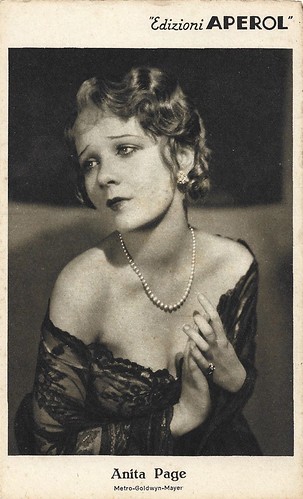
Italian postcard by Edizioni Aperol, Padova. Photo: Metro-Goldwyn-Mayer.
Beautiful Anita Page (1910–2008) was one of the most popular leading ladies of Hollywood during the last years of the silent screen and the first years of the sound era. According to MGM, she received the most fan mail at the time and her nickname was "the girl with the most beautiful face in Hollywood".
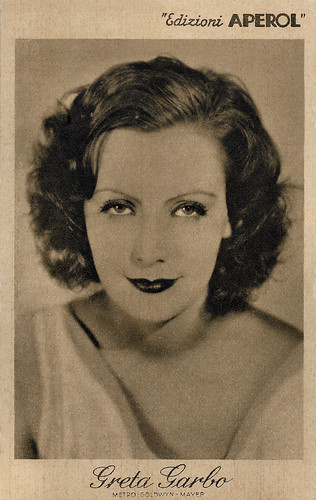
Italian postcard by Edizioni Aperol, Padova. Photo: Metro-Goldwyn-Mayer.
Swedish Greta Garbo (1905-1990) was one of the greatest and most glamorous film stars ever produced by the Hollywood studio system. She was part of the Golden Age of the silent cinema of the 1920s and was one of the few actors who made a glorious transition to the talkies. She started her career in European cinema and would always stay more popular in Europe than in the USA.
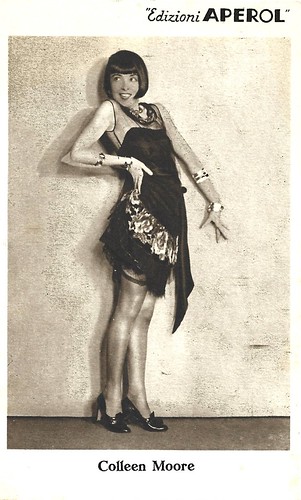
Italian postcard by Edizioni Aperol / Gazzettino di Venezia. Photo: First National. Colleen Moore in Synthetic Sin (William A. Seiter, 1929).
American actress Colleen Moore (1899-1988) was a star of the silent screen who appeared in about 100 films beginning in 1917. During the 1920s, she put her stamp on American social history, creating in dozens of films the image of the wide-eyed, insouciant flapper with her bobbed hair and short skirts.
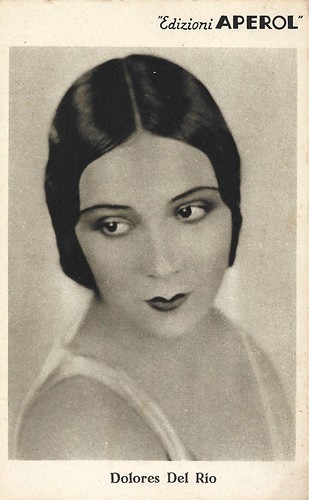
Italian postcard by Edizioni Aperol, Padova.
Mexican and American actress Dolores del Río (1905–1983) was a Hollywood star in the 1920s and 1930s, and one of the most important female actresses of the Golden Age of Mexican cinema in the 1940s and 1950s. Del Río was the first major Latin cross-over star in Hollywood and was considered one of the most beautiful faces that have emerged in Hollywood cinema. She also appeared in several European films.

Italian postcard by Edizioni Aperol, Padova. Photo: Ruth Harriet Louise / Metro Goldwyn Mayer.
Josephine Dunn (1906-1983) was an American film actress of the 1920s and 1930s. Dunn got her start as a Broadway chorine when she was only 15 and began working at Paramount five years later, going on to play leading roles through the early 1930s. Later she played supporting leads and was typically cast as the villainess. She left films in 1933.
Women were permitted to drink it
The factory of Aperol and Ovoso was located in Via Niccolò Tomassea in Padova (Padua), as the postcard below shows. The owners were the Barbieri brothers, Luigi and Silvio, who had founded the factory in 1919.
Luigi and Silvio Barbieri created their Aperol aperitivo in 1919 in the liqueur company of their father, after seven years of experimentation. Aperol Barbieria with its distinctive orange-red colour is made from bitter orange, gentian root, rhubarb and a wide range of herbs and roots. The two brothers presented their liquor as a 'therapeutic restorative product'. As the alcohol percentage of Aperol was initially low, women were permitted to drink it.
In the following years, Aperol became popular all over Italy, particularly with young adults gathered in cafes in Padua and traditional bars in Venice. Its bittersweet flavour made the drink very popular as an aperitif. In 1943 the original factory was bombed down, but three years later, the new premises were built in Via Gattamelata, also in Padua.
In the 1950s, the Aperol 'Spritz' was born and the cocktail became very popular in Italy. The recipe is 3 parts of Prosecco D.O.C. (9cl), 2 parts of Aperol (6cl), 1 splash of soda or seltzer (3cl) and 1 slide of orange. This is also the period of the RAI TV advertising programme Carosello with the first Aperol TV commercial, in which actor Tino Buazzelli, bringing his hand to his forehead, pronounced the words 'Ah, Aperol!'.
In 2003 the brand was taken over by Gruppo Campari, but the name still exists. From then on, Spritz spread through Northern Europe as well. Although it smells, tastes and looks like Campari, Aperol has an alcohol content of only 11%, where Campari contains 25% alcohol. Campari is also a bit darker in colour.
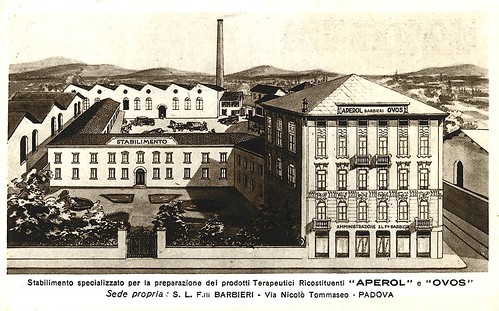
Italian postcard by Edizioni Aperol, ca. 1927-1931. Image: Gazzettino di Venezia.
Factory of Aperol and Ovoso, Via Niccolò Tommaseo, Padova, owned by Fratelli Barbieri. 'A factory specialised in therapeutic restorative products'.
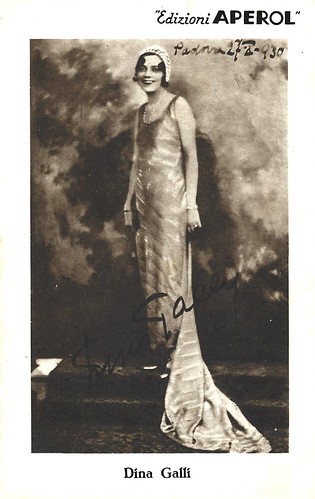
Italian postcard by Edizioni Aperol / Gazzettino di Venezia. Signed and dated, Padova, 27-10-1930.
Dina Galli (1877-1951) was a classic Italian comedienne who also performed in Italian silent and sound cinema.
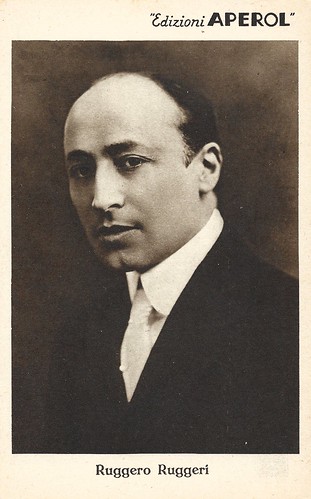
Italian postcard by Edizioni Aperol.
Ruggero Ruggeri (1871-1953) was one the most important Italian stage actors of the first half of the twentieth century. He appeared also in many films.
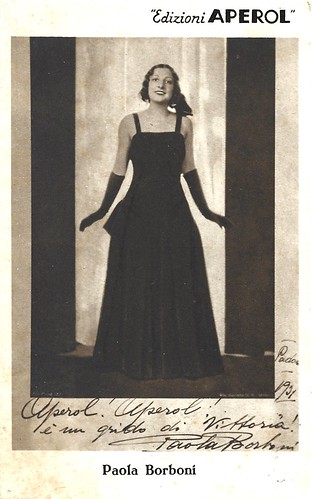
Italian postcard by Edizioni Aperol / Gazzettino di Venezia. Signed by Paola Borboni, Padova 1931. Caption: Aperol! Aperol! è un grido di Vittoria! (Aperol! is a cry of Victory!).
Paola Borboni was one of the greatest stage actresses of Italy (1900-1995). She also played in many films. She was often heard on the radio and seen on television, but her true passion was the stage.
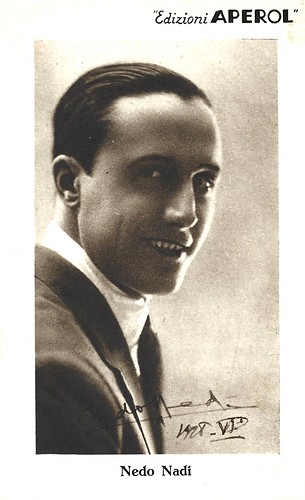
Italian postcard by Edizioni Aperol / Gazzettino di Venezia, 1928.
Nedo Nadi (1894-1940) was one of the most versatile fencers in Olympic history. He was the only one to win titles with all three different weapons at the same Olympic Games in Antwerp in 1920. In Antwerp, he also won the most fencing gold medals ever at a single Games — five.
The revival of the Italian cinema
Following Aperol’s acquisition by Gruppo Campari, the brand started a strong advertising campaign behind Aperol Spritz which built strong ties between consumers and Aperol Spritz through art, music and lifestyle.
In the 1920s, Campari introduced its 'aperitivo' in France with a French postcard campaign with stars of the French silent cinema. The postcard series linked the Italian aperitivo Campari to Paris and to film stars.
Between ca. 1927 and 1931, Aperol tried to do the same with a postcard series of American and Italian stars. The format was 13,8 x 8,8 cm. The series was published by Edizioni Aperol and printed by Gazzettino di Venezia. Aperol is promoted on both sides of the cards.
Some of the postcards of Italian stars such as Paola Borboni and Armando Falconi contain a dedication in which the actors promote Aperol. The only non-actor on the cards is the Olympic fencer Nedo Nadi. Some Italian stars were stage actors, like Ruggero Ruggeri, who had been film stars before the crisis in the Italian film industry in the early 1920s.
The Edizioni Aperol series illustrates how the Italian cinema revived after the introduction of sound film. At the bottom right of the pictures of some of the cards is the logo of the Italian film company Cines-Pittaluga. Stefano Pittaluga (1887-1932) acquired the pioneering film studio Cines from the conglomerate Unione Cinematografica Italiana. Cines-Pittaluga produced the first Italian sound film La canzone dell'amore/The Song of Love (1930), and became the dominant force of the early sound era.
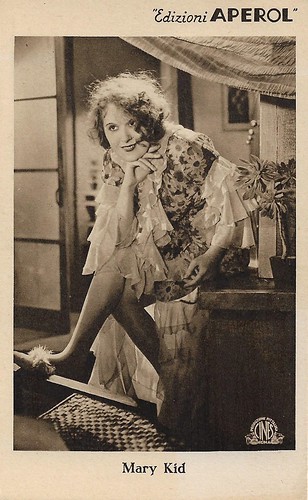
Italian postcard by Edizioni Aperol. Photo: Cines-Pittaluga, Roma.
Mary Kid (1901-1988) was a popular actress of the Austrian and German silent cinema. In 1931 Kid went to Italy where she played in her only two sound films. The first was Rubacuori/Heartbreaker (1931), a comedy by Guido Brignone about an old Casanova (Armando Falconi) who hunts young women until his wife (Tina Lattanzi) finds a jewel that belongs to one of his girlfriends. Falconi’s character comes between a prize fighter (Egon Stief) and his wife (Mary Kid). Kid's second Italian film was Kennst Du das Land (1931), the German version of Terra Madre and directed by Constantin J. David. Though produced by the Italian company Cines-Pittaluga and shot by an Italian crew, the cast was German-Austrian.
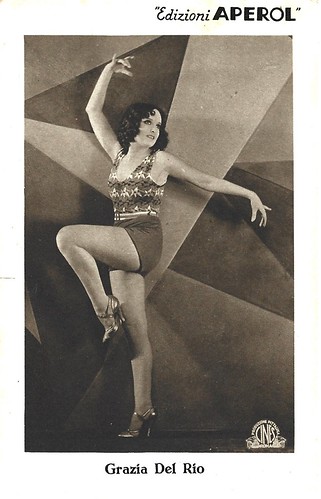
Italian postcard by Edizioni Aperol. Photo: Cines-Pittaluga, Roma.
Little is known about the personal life of Italian actress and singer Grazia Del Rio. Probably because of her singing voice and clear vocals, she had a prolific career in the earliest years of sound cinema. Between 1930 and 1933, she had a short but intense film career in Italy and France, peaking with La stella del cinema (Mario Almirante, 1931) in which she starred. In the late 1930s, she had a second career in Argentina and Chile.

Italian postcard by Edizioni Aperol / Gazzettino di Venezia.
Armando Falconi (1871-1954) was an Italian stage and screen actor. Though he was foremost a theatre actor and comedian, he had a prolific career as a comedian in the 1930s and early 1940s Italian cinema.

Italian postcard by Edizioni Aperol / Gazzettino di Venezia.
Ermete Zacconi (1857-1948) was a monstre sacré of the Italian theater. He also acted in various Italian silent and sound films.
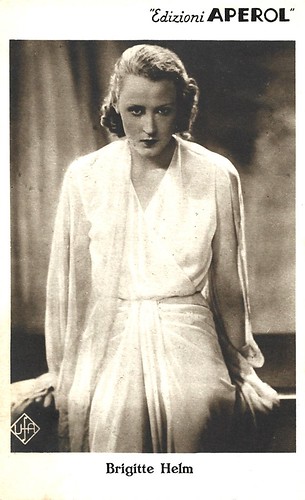
Italian postcard by Edizioni Aperol / Gazzettino di Venezia.
German actress Brigitte Helm (1908-1996) is still famous for her dual role as Maria and her double, the evil Maria, the Maschinenmensch, in the silent SF classic Metropolis (Fritz Lang, 1927). After Metropolis, she made a string of over 30 films in which she almost always had the starring role. She easily made the transition to sound film, before she abruptly retired in 1935.

Italian postcard by Edizioni Aperol / Gazzettino di Venezia.
We don't know who Mady Pohja was but Pohja, aka Pooja, is a Finnish last name.
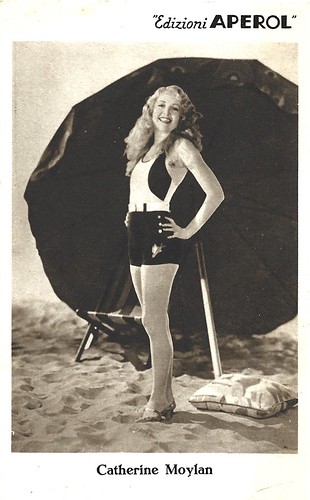
Italian postcard by Edizioni Aperol / Gazzettino di Venezia.
Catherine Moylan (1904-1969) was an American actress of Belgian origin and the first Miss Universe in 1926. After signing with MGM Studios, she began a brief film career in 1930, appearing in two films.
Sources: Aperol and Wikipedia (Italian and Dutch). Check out our posts on the French Campari postcards.
No comments:
Post a Comment